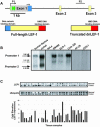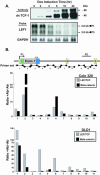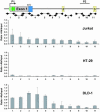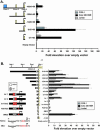Wnt activation and alternative promoter repression of LEF1 in colon cancer
- PMID: 16809766
- PMCID: PMC1592719
- DOI: 10.1128/MCB.00105-06
Wnt activation and alternative promoter repression of LEF1 in colon cancer
Abstract
Alternative promoters within the LEF1 locus produce polypeptides of opposing biological activities. Promoter 1 produces full-length LEF-1 protein, which recruits beta-catenin to Wnt target genes. Promoter 2 produces a truncated form that cannot interact with beta-catenin and instead suppresses Wnt regulation of target genes. Here we show that promoter 1 is aberrantly activated in colon cancers because it is a direct target of the Wnt pathway. T-cell factor (TCF)-beta-catenin complexes bind to Wnt response elements in exon 1 and dynamically regulate chromatin acetylation and promoter 1 activity. Promoter 2 is delimited to the intron 2/exon 3 boundary and, like promoter 1, is also directly regulated by TCF-beta-catenin complexes. Promoter 2 is nevertheless silent in colon cancer because an upstream repressor selectively targets the basal promoter leading to destabilized TCF-beta-catenin binding. We conclude that the biological outcome of aberrant LEF1 activation in colon cancer is directed by differential promoter activation and repression.
Figures









Similar articles
-
A unique DNA binding domain converts T-cell factors into strong Wnt effectors.Mol Cell Biol. 2007 Dec;27(23):8352-63. doi: 10.1128/MCB.02132-06. Epub 2007 Sep 24. Mol Cell Biol. 2007. PMID: 17893322 Free PMC article.
-
Beta-catenin-sensitive isoforms of lymphoid enhancer factor-1 are selectively expressed in colon cancer.Nat Genet. 2001 May;28(1):53-7. doi: 10.1038/ng0501-53. Nat Genet. 2001. PMID: 11326276
-
Mastermind-like 1 Is a specific coactivator of beta-catenin transcription activation and is essential for colon carcinoma cell survival.Cancer Res. 2007 Sep 15;67(18):8690-8. doi: 10.1158/0008-5472.CAN-07-1720. Cancer Res. 2007. PMID: 17875709
-
Lymphoid enhancer factor/T cell factor expression in colorectal cancer.Cancer Metastasis Rev. 2004 Jan-Jun;23(1-2):41-52. doi: 10.1023/a:1025858928620. Cancer Metastasis Rev. 2004. PMID: 15000148 Review.
-
The role of LEF/TCF factors in neoplastic transformation.Curr Mol Med. 2008 Feb;8(1):38-50. doi: 10.2174/156652408783565559. Curr Mol Med. 2008. PMID: 18289012 Review.
Cited by
-
Cell-context dependent TCF/LEF expression and function: alternative tales of repression, de-repression and activation potentials.Crit Rev Eukaryot Gene Expr. 2011;21(3):207-36. doi: 10.1615/critreveukargeneexpr.v21.i3.10. Crit Rev Eukaryot Gene Expr. 2011. PMID: 22111711 Free PMC article. Review.
-
Transforming growth factor-β1 enhances proliferative and metastatic potential by up-regulating lymphoid enhancer-binding factor 1/integrin αMβ2 in human renal cell carcinoma.Mol Cell Biochem. 2020 Feb;465(1-2):165-174. doi: 10.1007/s11010-019-03676-8. Epub 2019 Dec 17. Mol Cell Biochem. 2020. PMID: 31848806
-
Differences in expression and function of LEF1 isoforms in normal versus leukemic hematopoiesis.Leukemia. 2020 Apr;34(4):1027-1037. doi: 10.1038/s41375-019-0635-1. Epub 2019 Nov 22. Leukemia. 2020. PMID: 31758089
-
T-cell factor 4 functions as a tumor suppressor whose disruption modulates colon cell proliferation and tumorigenesis.Proc Natl Acad Sci U S A. 2011 Mar 22;108(12):4914-9. doi: 10.1073/pnas.1102300108. Epub 2011 Mar 7. Proc Natl Acad Sci U S A. 2011. PMID: 21383188 Free PMC article.
-
Lef1DeltaN binds beta-catenin and increases osteoblast activity and trabecular bone mass.J Biol Chem. 2011 Apr 1;286(13):10950-9. doi: 10.1074/jbc.M110.165100. Epub 2011 Jan 26. J Biol Chem. 2011. PMID: 21270130 Free PMC article.
References
-
- Aoki, M., V. Sobek, D. J. Maslyar, A. Hecht, and P. K. Vogt. 2002. Oncogenic transformation by beta-catenin: deletion analysis and characterization of selected target genes. Oncogene 21:6983-6991. - PubMed
-
- Atcha, F. A., J. E. Munguia, T. W. Li, K. Hovanes, and M. L. Waterman. 2003. A new beta-catenin-dependent activation domain in T cell factor. J. Biol. Chem. 278:16169-16175. - PubMed
-
- Batlle, E., J. T. Henderson, H. Beghtel, M. M. van den Born, E. Sancho, G. Huls, J. Meeldijk, J. Robertson, M. van de Wetering, T. Pawson, and H. Clevers. 2002. β-Catenin and TCF mediate cell positioning in the intestinal epithelium by controlling the expression of EphB/EphrinB. Cell 111:251-263. - PubMed
Publication types
MeSH terms
Substances
Grants and funding
LinkOut - more resources
Full Text Sources
Other Literature Sources
Miscellaneous
